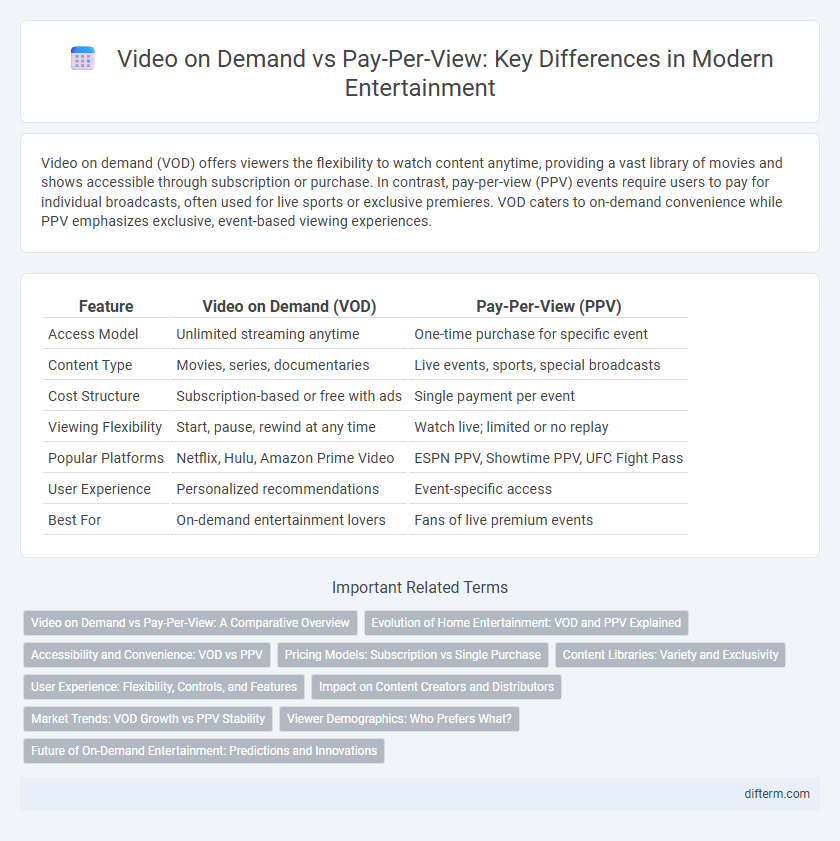Video on demand (VOD) offers viewers the flexibility to watch content anytime, providing a vast library of movies and shows accessible through subscription or purchase. In contrast, pay-per-view (PPV) events require users to pay for individual broadcasts, often used for live sports or exclusive premieres. VOD caters to on-demand convenience while PPV emphasizes exclusive, event-based viewing experiences.
Table of Comparison
| Feature | Video on Demand (VOD) | Pay-Per-View (PPV) |
|---|---|---|
| Access Model | Unlimited streaming anytime | One-time purchase for specific event |
| Content Type | Movies, series, documentaries | Live events, sports, special broadcasts |
| Cost Structure | Subscription-based or free with ads | Single payment per event |
| Viewing Flexibility | Start, pause, rewind at any time | Watch live; limited or no replay |
| Popular Platforms | Netflix, Hulu, Amazon Prime Video | ESPN PPV, Showtime PPV, UFC Fight Pass |
| User Experience | Personalized recommendations | Event-specific access |
| Best For | On-demand entertainment lovers | Fans of live premium events |
Video on Demand vs Pay-Per-View: A Comparative Overview
Video on Demand (VoD) offers viewers unlimited access to a vast library of content anytime, enhancing user convenience and personalized viewing experiences. In contrast, Pay-Per-View (PPV) requires individual payment for specific live or scheduled events, often favored for exclusive sports and live entertainment broadcasts. VoD platforms like Netflix and Amazon Prime emphasize content variety and subscription models, whereas PPV services focus on one-time purchases for high-demand events, impacting consumer choice and pricing structures in the entertainment industry.
Evolution of Home Entertainment: VOD and PPV Explained
Video on Demand (VOD) and Pay-Per-View (PPV) have revolutionized home entertainment by offering flexible and convenient content access. VOD allows users to stream or download a vast library of movies and shows anytime, while PPV provides exclusive live events such as sports or concerts for a one-time fee. The evolution from traditional broadcast to these digital platforms has significantly enhanced user control, content variety, and personalized viewing experiences.
Accessibility and Convenience: VOD vs PPV
Video on Demand (VOD) offers unparalleled accessibility by allowing users to stream content anytime and anywhere with an internet connection, eliminating fixed schedules. Pay-Per-View (PPV) restricts access to specific live events at preset times, requiring viewers to tune in at the exact broadcast moment. VOD's convenience significantly enhances the user experience by providing on-demand access to a diverse library, whereas PPV's model suits exclusive, time-sensitive programming.
Pricing Models: Subscription vs Single Purchase
Video on demand (VOD) typically operates on a subscription pricing model, offering unlimited access to a library of content for a monthly or annual fee. Pay-per-view (PPV) requires consumers to make single purchases for individual events or movies, often at a higher cost per title. Subscription services provide cost efficiency for frequent viewers, whereas PPV caters to audiences seeking specific, often live, content without ongoing commitments.
Content Libraries: Variety and Exclusivity
Video on demand offers extensive content libraries with a wide variety of movies, TV shows, and exclusive original productions accessible anytime. Pay-per-view focuses on exclusive, time-limited events such as live sports, concerts, and premieres that are not available in on-demand libraries. The difference in content variety and exclusivity defines consumer choice between unlimited streaming options and premium event access.
User Experience: Flexibility, Controls, and Features
Video on demand (VOD) offers users greater flexibility by allowing anytime access to a vast library of content with personalized controls like pause, rewind, and fast-forward. Pay-per-view (PPV) restricts viewing to specific scheduled events, limiting user control and interaction. Advanced features such as multi-device compatibility, customizable subtitles, and personalized recommendations enhance the user experience on VOD platforms compared to the often one-time-use nature of PPV services.
Impact on Content Creators and Distributors
Video on demand (VOD) platforms provide content creators with recurring revenue through subscription models, enabling continuous audience engagement and data-driven content optimization. Pay-per-view (PPV) offers immediate, event-driven income but limits long-term viewer interaction, often requiring heavy promotion for single-event monetization. Distributors benefit from VOD's scalable distribution and broader audience reach, while PPV generates high-margin returns for exclusive, time-sensitive content like live sports or premieres.
Market Trends: VOD Growth vs PPV Stability
The video on demand (VOD) market is experiencing rapid growth, driven by increasing consumer preference for flexible, on-demand access to diverse content libraries. In contrast, pay-per-view (PPV) remains relatively stable, primarily sustaining niche audiences through exclusive live events such as sports and concerts. Market analysis indicates VOD's expansion is fueled by subscription services and technological advancements, while PPV maintains steady revenue through event-based pricing models.
Viewer Demographics: Who Prefers What?
Younger viewers, particularly millennials and Gen Z, predominantly favor video on demand (VOD) services due to the convenience of watching content anytime and the extensive library available. Pay-per-view (PPV) appeals more to sports fans and niche audiences who prioritize live, exclusive events like boxing matches or concerts. Research indicates that households with higher incomes and cable subscriptions are more inclined toward PPV, while streaming-savvy demographics with mobile access prefer VOD platforms.
Future of On-Demand Entertainment: Predictions and Innovations
The future of on-demand entertainment is poised for rapid transformation through integrated AI-driven content curation and immersive virtual reality experiences, enabling unparalleled personalization for viewers. Advancements in cloud streaming technology and 5G networks will minimize latency, making high-quality video-on-demand services more accessible globally, while pay-per-view models evolve with blockchain-based secure transactions ensuring transparent and fair access. Innovations such as interactive storytelling and AI-generated content promise to redefine user engagement, positioning on-demand platforms as the dominant mode of entertainment consumption in the coming decade.
video on demand vs pay-per-view Infographic

 difterm.com
difterm.com